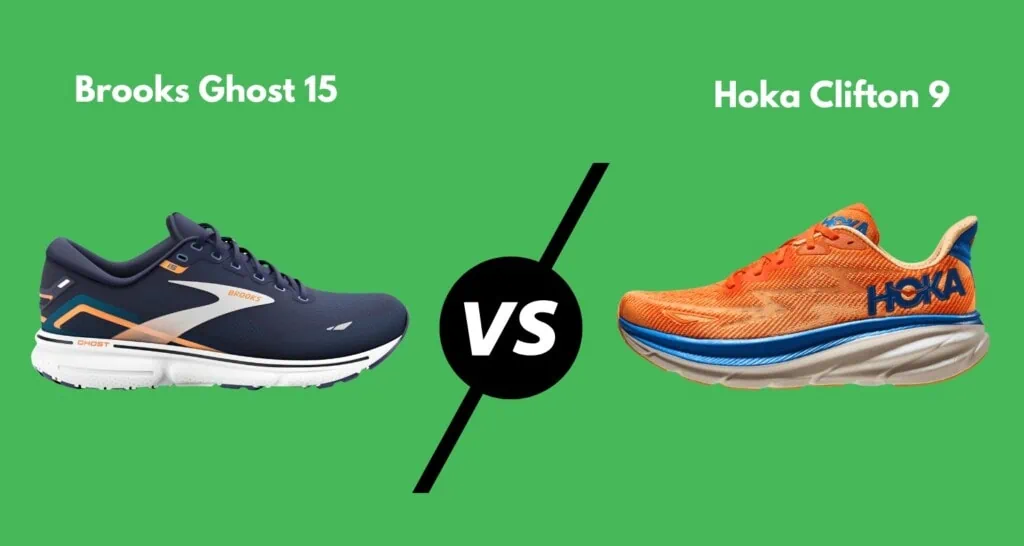The running shoe market has exploded in recent years, but two names consistently dominate conversations among runners, walkers, and podiatrists: Hoka vs Brooks. Both brands are beloved for their comfort, cushioning, and performance, but they offer very different approaches to shoe design.
If you’ve ever stood in a running store debating between the two—or scrolled endlessly through online reviews trying to decide which is better—you’re not alone. Having worn multiple pairs from both brands (seven styles in total) over the course of months, I’ve formed strong opinions about where each excels. To get the most complete picture, I also looked to podiatrists, who see firsthand how shoes affect foot health.
So, when it comes down to Hoka vs Brooks, which running shoe is better? The answer depends on your feet, your activities, and your preferences. Let’s break it down.
Hoka vs Brooks: Key Differences
At first glance, the two brands (Hoka vs Brooks) look strikingly different. Hoka shoes are unmistakable thanks to their maximalist style—extra-thick midsoles and a rocker-shaped design that looks bold and futuristic. Brooks, on the other hand, tends to be more traditional and understated, appealing to runners who value reliability over flash.
But beyond looks, there are important differences:
- Cushioning:
Hoka is famous for its ultra-soft, plush cushioning and signature Meta-Rocker technology, which helps propel your foot forward with each step. Podiatrists often recommend Hokas for people dealing with pressure-related pain or conditions like Achilles tendinitis because of the higher heel-to-toe drop and shock absorption. Brooks, while not “maximalist,” has its own standout cushioning systems like DNA LOFT and DNA AMP, which adapt to your stride. Brooks cushioning is typically firmer and more stable than Hoka’s, which many runners prefer for balance and longevity. - Stability:
Brooks shines here. With technologies like GuideRails, their shoes keep your stride aligned, reducing excess movement that can cause pain or injury. Podiatrists often recommend Brooks to people with flat feet or overpronation because of this focus on structure. Hoka do offer stability models, but their emphasis leans more toward plush comfort than rigid support. - Widths and Fit:
Both brands run true to size, but Brooks offers more width options—narrow, regular, wide, and extra-wide—making it a great choice for people with harder-to-fit feet. Hoka typically offers only regular and wide widths, though its roomy toe box often accommodates different foot shapes. - Aesthetics:
Hokas have recently become a fashion statement, spotted everywhere from marathons to the streets of New York City. Brooks maintains a more understated, classic athletic look.
Expert Insights from Podiatrists
Dr. Elizabeth Daughtry, D.P.M., stresses that a good running shoe should include a firm, padded midsole, solid arch support, and a wide toe box. She also notes the importance of breathable mesh in the upper for ventilation. Both Hoka and Brooks meet these standards, but in different ways.
Dr. Anne Sharkey, D.P.M., adds:
- “I recommend Hoka for cushioning and alleviation of pressure and pain.”
- “I recommend Brooks for stability and support. Brooks is an excellent choice for those with flat feet needing extra stability.”
In short, podiatrists see Hoka as the cushioning champion and Brooks as the stability leader.
How I Compared Hoka vs Brooks
Over several months, I wore seven pairs across both brands (Hoka vs Brooks), including the Hoka Clifton 9, Bondi 8, and Arahi, and the Brooks Ghost 16, Adrenaline GTS, and Glycerin StealthFit 21. I tested them walking long distances in New York City, jogging, and even wearing them casually throughout the day.
By combining personal wear tests with podiatrist insights, I was able to evaluate the two brands across categories that matter most: everyday use, cushioning, and stability.
Everyday Shoes: Hoka Clifton 9 vs. Brooks Ghost 16
Hoka Clifton 9
- Weight: 7.3 oz
- Heel-to-Toe Drop: 5 mm
- Stability: Neutral
- Cushion: Balanced
The Clifton 9 is Hoka’s most versatile everyday shoe. It’s lightweight, breathable, and features that signature rocker sole, making each step feel smoother and more efficient. For long days of walking or casual runs, the Clifton 9 shines. They’re also one of the trendiest sneakers out there—just walk a block in NYC and you’ll see plenty.
Pros: Extremely cushioned, lightweight, stylish, wide widths available.
Cons: Rocker design can feel odd for some, not ideal for gym work.
Brooks Ghost 16
- Weight: 9.5 oz
- Heel-to-Toe Drop: 12 mm
- Stability: High
- Cushion: Soft, but not plush
The Ghost is a Brooks classic and a reliable neutral runner. While not as fashion-forward as Hoka, the Ghost 16 provides consistent comfort and durability. The cushioning feels firmer compared to Hoka, but that firmness translates into better stability and longevity. It also carries the APMA Seal of Acceptance, meaning it’s been independently certified to promote foot health.
Pros: Supportive, versatile, podiatrist-approved.
Cons: Less trendy design, slightly heavier.
Winner (Everyday Use): Hoka Clifton 9.
It’s more versatile for walking and casual wear, while the Ghost is my go-to for workouts or long-distance walks.
Most Cushioning: Hoka Bondi 8 vs. Brooks Glycerin StealthFit 21
Hoka Bondi 8
- Weight: 8.9 oz
- Heel-to-Toe Drop: 4 mm
- Stability: Neutral
- Cushion: Plush
If cushioning is your number one priority, the Bondi 8 delivers. Each step feels like walking on clouds. For runners or walkers with joint pain, knee issues, or arthritis, this model is a dream. However, the thick midsole makes the shoe bulky, and it’s not the best for lateral movements or stability.
Pros: Unparalleled cushioning, roomy fit, forgiving ride.
Cons: Bulky, less stable.
Brooks Glycerin StealthFit 21
- Weight: 8.3 oz
- Heel-to-Toe Drop: 10 mm
- Stability: Neutral
- Cushion: Max
The Glycerin StealthFit 21 surprised me. With maximum cushioning and a sleek, sock-like fit, it feels plush but also structured. The DNA LOFT v3 cushioning provides softness without being overly squishy, making it a better balance between comfort and support.
Pros: Super-cushioned, adaptable fit, sleek design.
Cons: Sock-like upper may rub on some feet.
Winner (Most Cushioning): Brooks Glycerin StealthFit 21.
While the Bondi 8 wins for cloud-like softness, the Glycerin provides cushioning with more stability, which I found more functional for daily use.
Stability: Brooks Adrenaline GTS vs. Hoka Arahi
Brooks Adrenaline GTS
This shoe is a legend in the stability category. Featuring GuideRails technology, it keeps excess motion in check, supporting your stride without feeling overly rigid. Podiatrists love it for people with flat feet or overpronation.
Hoka Arahi
The Arahi is Hoka’s answer to a stability shoe. It provides support while still offering Hoka’s signature cushioning and rocker sole. However, it doesn’t feel as structured as the Adrenaline, and for people who truly need stability, Brooks wins this round.
Winner (Stability): Brooks Adrenaline GTS.
Price and Durability
Both brands fall into a similar price range, typically $140–$170 for new releases. Hokas sometimes wear down faster because of the softer foam, especially if used heavily for running. Brooks, with slightly firmer midsoles, often last a bit longer.
The Final Verdict
So, which is better: Hoka vs Brooks?
- Everyday Wear: Hoka Clifton 9 wins for style, comfort, and versatility.
- Most Cushioning: Brooks Glycerin StealthFit 21 edges out the Bondi 8 for combining plush comfort with stability.
- Stability: Brooks Adrenaline GTS is the clear leader for those needing structured support.
Ultimately, it comes down to your feet and your needs. If you want ultra-soft cushioning and a trendy, modern look, Hoka is your brand. If you need reliability, stability, and podiatrist-approved support, Brooks is tough to beat.
As Dr. Daughtry reminds us, the best shoe is one that balances cushioning with excellent arch support, tailored to your unique gait. What works for one runner may not work for another, so it’s worth trying both brands to see which feels like the best fit for you.
Read More:
https://onclouder.com/comparison/hoka/hoka-vs-new-balance/

